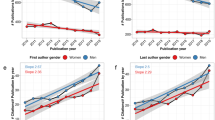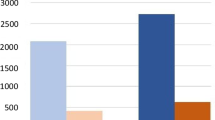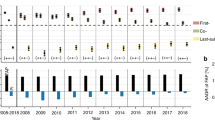Abstract
Gender and sex analysis is increasingly recognized as a key factor in creating better medical research and health care1,2,3,4,5,6,7. Using a sample of more than 1.5 million medical research papers, our study examined the potential link between women’s participation in medical science and attention to gender-related and sex-related factors in disease-specific research. Adjusting for variations across countries, disease topics and medical research areas, we compared the participation of women authors in studies that do and do not involve gender and sex analysis. Overall, our results show a robust positive correlation between women’s authorship and the likelihood of a study including gender and sex analysis. These findings corroborate discussions of how women’s participation in medical science links to research outcomes, and show the mutual benefits of promoting both the scientific advancement of women and the integration of gender and sex analysis into medical research.
This is a preview of subscription content, access via your institution
Access options
Access Nature and 54 other Nature Portfolio journals
Get Nature+, our best-value online-access subscription
$29.99 / 30 days
cancel any time
Subscribe to this journal
Receive 12 digital issues and online access to articles
$119.00 per year
only $9.92 per issue
Buy this article
- Purchase on Springer Link
- Instant access to full article PDF
Prices may be subject to local taxes which are calculated during checkout


Similar content being viewed by others
References
Arnold, A. P. Promoting the understanding of sex differences to enhance equity and excellence in biomedical science. Biol. Sex Differ. 1, 1 (2010).
Schiebinger, L., Leopold, S. S. & Miller, V. M. Editorial policies for sex and gender analysis. Lancet 388, 2841–2842 (2016).
Recommendations for the Conduct, Reporting, Editing, and Publication of Scholarly Work in Medical Journals (International Committee of Medical Journal Editor, 2016); http://www.icmje.org/news-and-editorials/icmje-recommendations_annotated_dec16.pdf.
Heidari, S., Babor, T. F., De Castro, P., Tort, S. & Curno, M. Sex and gender equity in research: rationale for the SAGER guidelines and recommended use. Res. Integr. Peer Rev. 1, 2 (2016).
Miller, V. M. In pursuit of scientific excellence: sex matters. Physiol. Genomics 44, 485–486 (2012).
Nieuwenhoven, L. & Klinge, I. Scientific excellence in applying sex- and gender-sensitive methods in biomedical and health research. J. Womens Health 19, 313–321 (2010).
Johnson, J. L., Greaves, L. & Repta, R. Better science with sex and gender: facilitating the use of a sex and gender-based analysis in health research. Int. J. Equity Health 8, 14 (2009).
Oertelt-Prigione, S. & Regitz-Zagrosek, V. (eds) Sex and Gender Aspects in Clinical Medicine (Springer, London, 2012).
Kim, E. S. H. & Menon, V. Status of women in cardiovascular clinical trials. Arterioscler. Thromb. Vasc. Biol. 29, 279–283 (2009).
Mosca, L., Hammond, G., Mochari-Greenberger, H., Towfighi, A. & Albert, M. A. Fifteen-year trends in awareness of heart disease in women results of a 2012 American Heart Association national survey. Circulation 127, 1254–1263 (2013).
Kwiatkowski, K., Coe, K., Bailar, J. C. & Swanson, G. M. Inclusion of minorities and women in cancer clinical trials, a decade later: have we improved? Cancer 119, 2956–2963 (2013).
Beery, A. K. & Zucker, I. Sex bias in neuroscience and biomedical research. Neurosci. Biobehav. Rev. 35, 565–572 (2011).
Shah, K., McCormack, C. E. & Bradbury, N. A. Do you know the sex of your cells? Am. J. Physiol. Cell Physiol. 306, C3–C18 (2014).
Klein, S. L. et al. Sex differences in the incidence and case fatality rates from hemorrhagic fever with renal syndrome in China, 2004–2008. Clin. Infect. Dis. 52, 1414–1421 (2011).
Adler, R. A. Osteoporosis in men: a review. Bone Res. 2, 14001 (2014).
Smith, P. M. & Koehoorn, M. Measuring gender when you don’t have a gender measure: constructing a gender index using survey data. Int. J. Equity Health 15, 82 (2016).
Courtenay, W. H. Behavioral factors associated with disease, injury, and death among men: evidence and implications for prevention. J. Mens Stud. 9, 81–142 (2000).
Alabas, O. A., Tashani, O. A., Tabasam, G. & Johnson, M. I. Gender role affects experimental pain responses: a systematic review with meta‐analysis. Eur. J. Pain 16, 1211–1223 (2012).
Pelletier, R. et al. Sex versus gender-related characteristics: which predicts outcome after acute coronary syndrome in the young? J. Am. Coll. Cardiol. 67, 127–135 (2016).
Schiebinger, L. & Stefanick, M. L. Gender matters in biological research and medical practice. J. Am. Coll. Cardiol. 67, 136–138 (2016).
US General Accounting Office Drug Safety: Most Drugs Withdrawn in Recent Years had Greater Health Risks for Women (Government Publishing Office, Washington DC, 2001).
Schiebinger, L. et al. Sex and Gender Analysis Policies of Major Granting Agencies (Gendered Innovations in Science, Health & Medicine, Engineering, and Environment, 2017); http://genderedinnovations.stanford.edu/sex-and-gender-analysis-policies-major-granting-agencies.html
Gender Equality in Horizon 2020 Version 2 (European Commission, 2016); http://ec.europa.eu/research/participants/data/ref/h2020/grants_manual/hi/gender/h2020-hi-guide-gender_en.pdf
Consideration of Sex as a Biological Variable in NIH-Funded Research (National Institutes of Health, 2015); https://grants.nih.gov/grants/guide/notice-files/NOT-OD-15-102.html.
Ely, R. J. & Thomas, D. A. Cultural diversity at work: the effects of diversity perspectives on work group processes and outcomes. Adm. Sci. Q. 46, 229–273 (2001).
Page, S. E. The Difference: How the Power of Diversity Creates Better Groups, Firms, Schools, and Societies (Princeton Univ. Press, Princeton, NJ, 2008).
Nielsen, M. W. et al. Opinion: gender diversity leads to better science. Proc. Natl Acad. Sci. USA 114, 1740–1742 (2017).
Charles, M. & Bradley, K. Indulging our gendered selves? Sex segregation by field of study in 44 countries. Am. J. Sociol. 114, 924–976 (2009).
Alers, M., van Leerdam, L., Dielissen, P. & Lagro-Janssen, A. Gendered specialities during medical education: a literature review. Perspect. Med. Educ. 3, 163–178 (2014).
West, J. D., Jacquet, J., King, M. M., Correll, S. J. & Bergstrom, C. T. The role of gender in scholarly authorship. PLoS ONE 8, e66212 (2013).
Light, R. in Networks, Work, and Inequality (ed. Mcdonald, S.) 239–268 (Research in the Sociology of Work Vol. 24, Emerald Group Publishing, Bingley, 2013).
Dolado, J. J., Felgueroso, F. & Almunia, M. Are men and women-economists evenly distributed across research fields? Some new empirical evidence. SERIEs 3, 367–393 (2012).
Kretschmer, H., Kundra, R., Beaver, D. D. & Kretschmer, T. Gender bias in journals of gender studies. Scientometrics 93, 135–150 (2012).
Söderlund, T. & Madison, G. Characteristics of gender studies publications: a bibliometric analysis based on a Swedish population database. Scientometrics 105, 1347–1387 (2015).
Johnson, J., Sharman, Z., Vissandjee, B. & Stewart, D. E. Does a change in health research funding policy related to the integration of sex and gender have an impact? PLoS ONE 9, e99900 (2014).
Oertelt-Prigione, S., Parol, R., Krohn, S., Preissner, R. & Regitz-Zagrosek, V. Analysis of sex and gender-specific research reveals a common increase in publications and marked differences between disciplines. BMC Med. 8, 70 (2010).
Oertelt-Prigione, S., Gohlke, B. O., Dunkel, M., Preissner, R. & Regitz-Zagrosek, V. GenderMedDB: an interactive database of sex and gender-specific medical literature. Biol. Sex Differ. 5, 7 (2014).
Gelman, A., Jakulin, A., Piitau, M. G. & Su, Y.-S. A weakly informative default prior distribution for logistic and other regression models. Ann. Appl. Stat. 2, 1360–1383 (2008).
Valantine, H. A. & Collins, F. S. National Institutes of Health addresses the science of diversity. Proc. Natl Acad. Sci. USA. 112, 12240–12242 (2015).
Gneezy, U., Niederle, M. & Rustichini, A. Performance in competitive environments: gender differences. Q. J. Econ. 118, 1049–1074 (2003).
Reskin, B. F. & Roos, P. A. (eds) Job Queues, Gender Queues: Explaining Women’s Inroads into Male Occupations (Temple Univ. Press, Philadelphia, PA, 1990).
Patel, V. M. et al. How has healthcare research performance been assessed? A systematic review. J. R. Soc. Med. 104, 251–261 (2011).
Young, N. S., Ioannidis, J. P. A. & Al-Ubaydli, O. Why current publication practices may distort science. PLoS Med. 5, e201 (2008).
Darmoni, S. J. et al. A MEDLINE categorization algorithm. BMC Med. Inform. Decis. Mak. 6, 7 (2006).
Martin, A. D., Quinn, K. M. & Park, J. H. MCMCpack: Markov Chain Monte Carlo in R. J. Stat. Softw. 42, 1–21 (2011).
Martin, A. D., Quinn, K. M. & Park, J. H. Package ‘MCMC-pack’ v.1.3-9 (R Foundation for Statistical Computing, 2017); https://cran.r-project.org/web/packages/MCMCpack/MCMCpack.pdf
Lenth, R. Package ‘lsmeans’ Version 2.2 (The Comprehensive R Archive Network, 2016); https://cran.r-project.org/web/packages/lsmeans/lsmeans.pdf
Acknowledgements
We thank S. Oertelt-Prigione and the Institute of Gender in Medicine, Charité-Universitätsmedizin Berlin, Germany, for data acquisition from the GenderMed database. The funders had no role in study design, data collection and analysis, decision to publish or preparation of the manuscript.
Competing interests
The authors declare no competing interests.
Author information
Authors and Affiliations
Contributions
The research was designed by M.W.N. The database was constructed by J.P.A. and M.W.N. The data were analysed by M.W.N., J.W.S. and J.P.A. All authors contributed to writing the paper.
Corresponding author
Additional information
Publisher’s note: Springer Nature remains neutral with regard to jurisdictional claims in published maps and institutional affiliations.
Electronic supplementary material
Supplementary Information
Supplementary Methods, Supplementary Figures 1–5, Supplementary Tables 1–14, Supplementary References
Rights and permissions
About this article
Cite this article
Nielsen, M.W., Andersen, J.P., Schiebinger, L. et al. One and a half million medical papers reveal a link between author gender and attention to gender and sex analysis. Nat Hum Behav 1, 791–796 (2017). https://doi.org/10.1038/s41562-017-0235-x
Received:
Accepted:
Published:
Issue Date:
DOI: https://doi.org/10.1038/s41562-017-0235-x
This article is cited by
-
Utilizing a composite citation index for evaluating clinical ophthalmology research: insights into gender, nationality, and self-citation among top ophthalmology researchers
Eye (2024)
-
Researchers' sex/gender identity influences how sex/gender question is investigated in neuroscience: an example from an OHBM meeting
Brain Structure and Function (2024)
-
Natural disasters, personal attributes, and social entrepreneurship: an attention-based view
Small Business Economics (2024)
-
A roadmap for sex- and gender-disaggregated health research
BMC Medicine (2023)
-
Strategies to achieve gender equity in nephrology
Nature Reviews Nephrology (2023)



